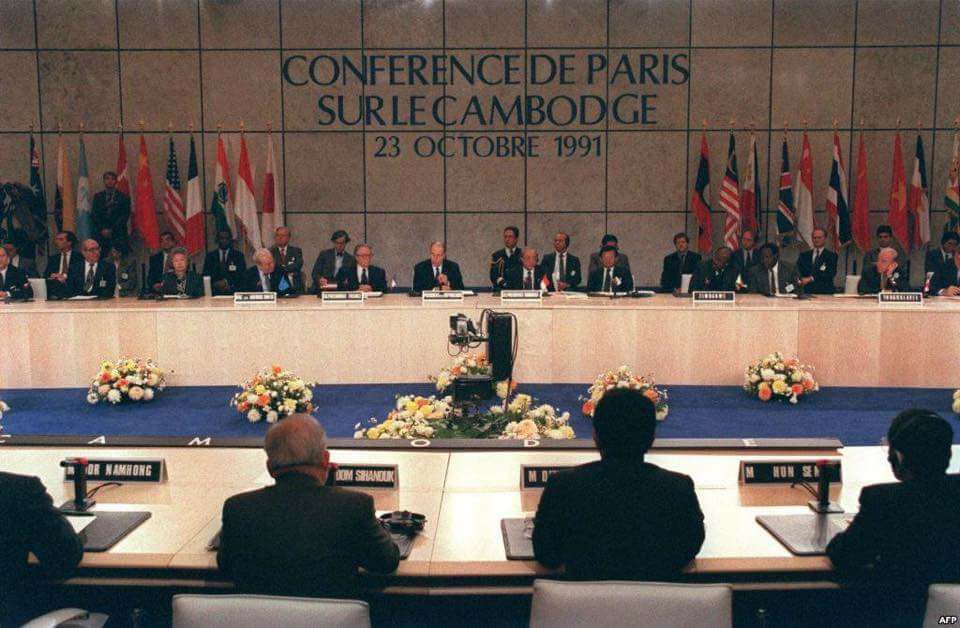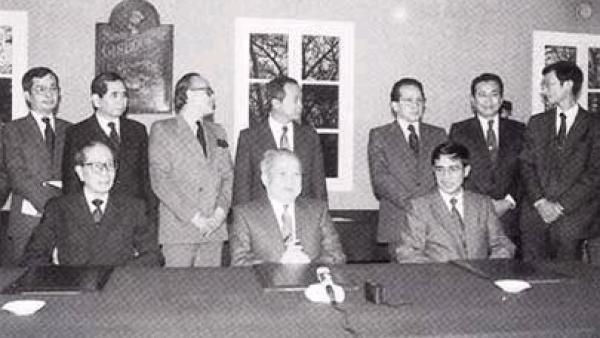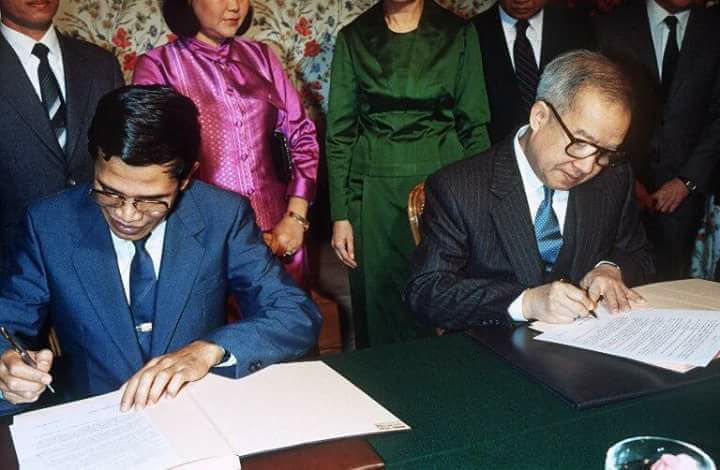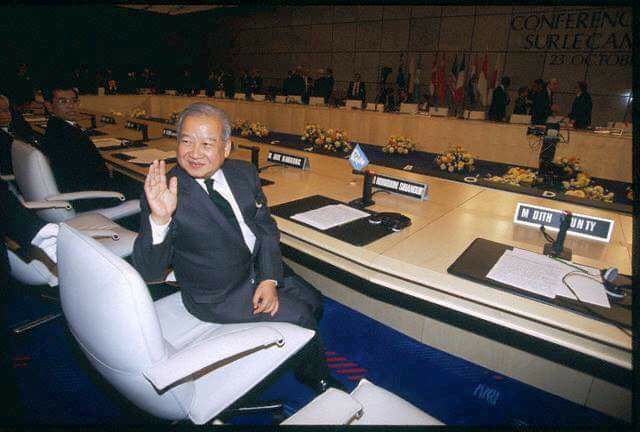The Paris Peace Agreements (Khmer: សន្ធិសញ្ញាសន្តិភាពទីក្រុងប៉ារីស, French: Accords de Paris), formally titled Comprehensive Cambodian Peace Agreements, were signed on October 23, 1991, after over a decade of negotiations, and marked the official end of the Cambodian–Vietnamese War. The agreement led to the deployment of the first post-Cold War peace keeping mission (UNTAC) and the first ever occasion in which the UN took over as the government of a state. The agreement was signed by nineteen countries.


The Paris Peace Agreements were the following conventions and treaties:
- The Final Act of the Paris Conference on Cambodia
- Agreement on the Political Settlement of the Cambodia Conflict
- Agreement Concerning the Sovereignty, Territorial Integrity and Inviolability, Neutrality and National Unity of Cambodia
- Declaration on the Rehabilitation and Reconstruction of Cambodia
October 23 is a public holiday in Cambodia to commemorate the anniversary of the Paris Peace Agreement. It was announced by the government in late 2012, but will no longer be observed as a holiday in 2020.
BACKGROUND ON THE NEGOTIATING PROCESS
On October 23 1991, the Agreements on a Comprehensive Political Settlement of the Cambodia Conflict were signed by Cambodia and 18 other nations in the presence of the United Nations Secretary-General. The agreements were the culmination of more than a decade of negotiations in which the Secretary-General had been closely involved from the outset.
The situation in Cambodia was first considered by the United Nations Security early in 1979. Later in the same year, the General Assembly considered the question at its regular session and adopted the first in a long series of resolutions on the subject. One of the provisions of that and succeeding resolutions requested the Secretary-General to follow the situation closely and to exercise his good offices in order to contribute to a peaceful solution to the problem. Another provision welcomed the efforts begun by the Secretary-General to coordinate relief assistance to the Cambodia people, assistance which, over the years, has now amounted to more than a billion dollars.
GOOD OFFICES
A few months following the International Conference on Kampuchea, convened in New York from 13 to 17 July 1981 by the General Assembly, Secretary-General Javier Pe’rez de Cuellar renewed the offer of good offices. He requested his Special Representative for Humanitarian Affairs in South-East Asia, Rafeeuddin Ahmed, to establish contacts with the principal countries concerned in order to assess the positions of the parties and encourage, through dialogue, the gradual reconciliation of viewpoints. Accordingly, Mr. Ahmed undertook a mission in February and March 1982 to consult with Governments in the region and to encourage them to consider the convening of a limited international conference to bring together the parties, regional countries concerned and the five permanent members of the Security Council. At the same time, the Secretary-General continued his own contacts with Governments, both at United Nations Headquarters and at capitals around the world. He reported to the General Assembly at its thirty-seventh session in 1982 that only a comprehensive political solution, achieved through genuine negotiations, would ultimately bring peace. He reiterated his determination to continue to exercise his good offices and to assist all parties concerned in the search for a negotiated settlement.
On the Secretary-General’s behalf, Mr. Ahmed visited the region many times over the years; in 1985, the Secretary-General himself did so. On the basis of his discussions, the Secretary-General was able to identify a number of objectives on which there seemed to be a degree of convergence. He listed these points in his reports to the General Assembly at its fortieth session in 1985, thus recording for the first time the maim elements of a comprehensive political settlement. His efforts over the next three years centred on identifying the circumstances in which these objective might be achieved.
In December 1987, Prince Norodom Sihanouk and Mr. Hun Sen met for the first time in France, and a month later held a second round of talks. Following the initiation of this dialogue, the Secretary-General decided in June 1988 to ask his Special Representative to travel to South-East Asia to relay to the four Cambodian parties and concerned Governments of the region certain concrete ideas which might serve as a framework for a comprehensive settlement plan. The proposals put forward by the Secretary-General elaborated the objectives he had identified in 1985 and proposed integration of the various elements into a comprehensive scheme leading to the establishment of an independent, neutral and non-aligned Cambodian state. In particular, the framework provided for an overall timeframe for a cease-fire and the withdrawal of all foreign forces from Cambodia, the disposition of the Cambodian armed elements, self-determination through free and fair general elections and the formation of a national reconciliation administration in Cambodia pending those elections, all with international supervision and verification; the repatriation and reintegration of refugees and displaced persons; and the implementation of measures, including a human rights education programme, to ensure the non-return to policies and practices of the past. In addition, the Secretary-General foresaw the provision of international guarantees for a settlement, and the launching of a programme for the rehabilitation and reconstruction of Cambodia. The Secretary-General clarified that this integrated approach was intended only as a focus for dialogue between the parties concerned, and that he was prepared to explore any other avenue to hasten a peaceful, just and lasting solution.
Following the Secretary-General’s proposals, the process of dialogue and negotiation gathered momentum, The first face-to-face talks between all four Cambodian parties took place on the occasion of the Jakarta Informal Meeting (JIM), hosted by Indonesia, in July 1988. Representative of Vietnam, the Lao people’s Democratic Republic and the Association of South-East Asian Nations were also invited. A second JIM was held in February 1989. Among the items discussed was the general understanding that an international control mechanism should play a role in supervising and controlling the implementation of any agreements reached by the parties. All four Cambodian parties again participated in talks held in Paris in July 1989, on the eve of the Paris Conference of Cambodia.

PARIS CONFERENCE ON CAMBODIA
Eighteen countries and the Cambodian parties attended the Conference, held from 30 July to 30 August 1989 at the initiative of France. The French and the Indonesian Foreign Minister acted as co-Presidents. Also participating in his official capacity was the Secretary-General of the United Nations. Addressing the opening session, the Secretary-General noted that, while the principle objectives of such a settlement was accepted by all, some significant substantive differences remained to be resolved. He subsequently put forward a number of working documents designed to facilitate bridging those differences. In particular, he addressed the military aspects in some detail, outlined the steps necessary for internationally supervised elections, put forward a proposal for the repatriation of refugees and displaced persons and outlined what the United Nations could do for the rehabilitation and reconstruction of Cambodia at the appropriate time. In addition, he pointed out that further information on the situation inside Cambodia would be necessary for the deployment of an international control mechanism, and that a fact-finding mission would go to Cambodia to gather the necessary technical information. The Conference agreed, and a mission was dispatched by the Secretary-General to visit the area from 6 to 19 August 1989.
When the Conference was suspended on 30 August, the concluding statement noted that, while progress had been made in elaborating a wide variety of elements, a comprehensive settlement had not yet been achieved. The Secretary-General, in his report to the forty-fourth session of the General Assembly in October 1989, pointed out that the most important outstanding issue was national reconciliation. To begin to resolve this issue, viable administrative arrangements had to be made for the transition period leading to free, fair and internationally supervised elections. Other details remained to be worked out as well. A firm basis for the negotiations required a genuine spirit of compromise. The Secretary-General assured all parties that he would continue to do whatever he could to further the negotiating process.

CONSULTATION OF THE FIVE
Among the countries attending the 1989 Paris Conference on Cambodia were the five permanent members of the Security Council: China, France, the Soviet Union, the United Kingdom and the United States. Their presence marked a shared interest in achieving a negotiated settlement. In January 1990, they began a series of high-level meetings successively in New York and in Paris to discuss the situation in Cambodia. The meetings were an unprecedented and highly-visible effort on the part of the Five to develop the basis of a general settlement agreement. The Secretary-General welcomed this initiative and reiterated that the United Nations would assume any appropriate role agreed upon by the parties concerned and approved by the Security Council. He stressed, however, that the mandate which might ultimately be entrusted to the United Nations should be well-defined, realistic and practicable, and that the Organization should be assured of the necessary resources for its effective implementation.
In the source of their deliberations, the Five considered an Australian proposal to enhance the role of the United Nations in the settlement process, and took account of the discussions among the Cambodian parties, including those at an Informal Meeting on Cambodia in Jakarta in February 1990, and, in June, at a meeting held in Tokyo. Throughout the process, the Five maintained regular contacts with the Secretary-General. They welcomed his decision to establish a Secretariat task force to facilitate contingency planning for an eventual United Nations operation in Cambodia. To facilitate their request for technical information form the United Nations Secretariat, several fact-finding missions were dispatched under the auspices of the Secretary-General to study, among other things, communication and transportation infrastructure, water supply, sanitation and housing; structure of the administration; and modalities for the repatriation of refugees and displaced persons and their reintegration into Cambodia.
At their sixth meeting on 27-28 August, the Five announced that they had reached agreement on a framework for a comprehensive political settlement of the Cambodia conflict. On the basis of this framework, the co-Presidents of the Paris Conference convened an informal meeting of the Cambodian parties in Jakarta. The meeting culminated, on 10 September, in a joint statement announcing that the four Cambodian parties accepted the framework, in its entirety, as the basis for settling the conflict, and were committed to elaborating this framework into a comprehensive political settlement through the processes of the Paris Conference. The joint statement further stipulated that the Cambodian parties agreed to form the Supreme National Council (SNC) as the unique legitimate body and source of authority in Cambodia throughout a transitional period. On 20 September 1990, the United Nations Security Council adopted resolution 668 endorsing the framework formulated by the Five.
The Five then called upon the co-Presidents of the Paris Conference to make the necessary arrangements for the elaboration of a comprehensive political settlement agreement based on the framework. A working group met on 9 and 10 November and achieved a general understanding on the structure and approach to be followed. Further consideration took place later that month when the representative of the co-Presidents of the Conference met with the Vice-Ministers for Foreign Affairs of the Five. The Secretary-General’s representative, Mr. Ahmed, actively participated in these and subsequent meetings.
THE DRAFT TEXT OF 26 NOVEMBER
On 26 November 1990, the co-Presidents and the Five agreed on a text containing three main parts, namely:1) a general agreement with detailed annexes covering the proposed mandate for the United Nations Transitional Authority in Cambodia( UNTAC); the military arrangements during the transitional period; elections; the repatriation of Cambodian refugees and displaced persons; and principles for a new constitution; 2) an agreement covering international guarantees; and 3) a declaration regarding the rehabilitation and reconstruction of Cambodia. From 21 to 23 December 1990, the co-Presidents convened a meeting with the SNC in order to present formally to the SNC members the 26 November text. The meeting resulted in concurrence on most of the fundamental points. In February, the draft agreements were presented to Cambodia’s neighbors, Thailand and Vietnam.
On 22 April 1991, the Secretary-General and the co-Presidents issued a joint appeal for a temporary cessation of hostilities, as a gesture of good faith, to create a favorable environment for the meeting at Jakarta of the co-Presidents and the members of the SNC. In response, the parties informed the Secretary-General that they intended to respect this appeal, voluntarily observing their first cease-fire in 12 years. At the Jakarta meeting from 4 to 6 June and at subsequent meetings in which the representative of the Secretary-General also participated, discussions in the remaining differences on the draft text were pursued. In mid-June 1991, Prince Norodom Sihanouk joined the SNC, and subsequently chaired its 24 to 26 June meeting in Pattaya, Thailand. A significant result of that meeting was the unanimous decision to call for an open-ended and unconditional cease-fire and for a halt to receiving outside military assistance. In July, at an informal meeting of the SNC in Beijing, it was agreed to elect Price Norodom Sihanouk president.
On 17 and 18 July, the Vice-Ministers of the five permanent members and the representative of Indonesia, in his capacity as co-President of the Paris Conference on Cambodia, also met in Beijing. They considered the results obtained at the SNC meetings and held a meeting with Prince Sihanouk, as President of the SNC, to exchange views on the situation and on the direction the negotiation process could be expected to take.
At its second formal meeting in Pattaya, from 26 to 29 August, the SNC considered the draft settlement agreements of November 26 1990, and, with the participation of the representative of the co-Presidents and of the Secretary-General, achieved significant progress in finding compromise solutions to most of the outstanding difficulties. This included, in particular, the question of the military arrangements during the transitional period. The SNC, through Prince Sihanouk, requested the Secretary-General to send a number of military observers to Cambodia, and to begin rehabilitation assistance for Cambodia as soon as possible.
On August 29 and 30, the Vice-Ministers of the permanent members of the Security Council and Indonesia also met in Pattaya. The progress made by the SNC, especially with respect to military matters, was considered. On 30 August, the first joint meeting of the co-Presidents, the five permanent members and the SNC was held. On 19 September, Price Sihanouk and other members of the SNC met informally with the representatives of the co-Presidents of the Paris Conference on Cambodia and with Mr. Ahmed in New York. Price Sihanouk indicated that the SNC had reached agreement on the issue of the electoral system to be used for the elections to be organized and conducted by the United Nations in Cambodia as part of the settlement agreement.
SIGNATURE OF THE AGREEMENTS
The Vice-Ministers of the five permanent members and the representative of the Indonesian co-President met in New York on 20 and 21 September to take stock of the situation. On 20 September, they held their second joint meeting with members of the SNC, at which Prince Sihanouk announced that the SNC had reached agreement on the question of the dicision-making process during the transitional period. On 21 September, the co-Presidents of the Paris Conference on Cambodia convened in New York an informal meeting of the Coordination Committee of the Conference. Following this meeting, Mr. Ahmed assisted the representatives of the co-Presidents in reviewing and revising the 26 November 1990 draft text in order to reflect the agreements reached during the preceding 10 months. The revised text was presented to the SNC on 27 September at another informal meeting held with the co-Presidents’ representatives and Mr. Ahmed. Subsequently, the co-Presidents made the revised text available to the other States participating in the Conference.
Following the visit to Cambodia at the request of the SNC of a military survey mission, the Secretary-General, on 30 September, recommended in a report to the Security Council the establishment of the United Nations Advance Mission in Cambodia (UNAMIC) to assist the Cambodian parties maintain their cease-fire, to exercise good offices and liaison functions during the period preceding the establishment of UNTAC, and to establish a mine awareness program. The Council approved the report on 16 October by its resolution 717(1991) and decided to establish UNAMIC immediately after the signing of the comprehensive settlement agreements.
The second session of the Paris Conference on Cambodia was held from 21 to 23 October 1991.The Agreements on a Comprehensive Political Settlement of the Cambodia Conflict were signed at the final meeting, on 23 October. This act marked the beginning of the transitional period in Cambodia, running up to the formation of a new Cambodian Government following free and fair elections. The Security Council expressed its full support for these Agreements on 31 October, in its resolution 718 (1991), and requested the preparation of a detailed plan of implementation.

For full details on the contents of the agreement see the links below (cambodia.org)
- AGREEMENT ON A COMPREHENSIVE POLITICAL SETTLEMENT OF THE CAMBODIA CONFLICTAnnex 1. UNTAC mandate
Annex 2. Withdrawal, cease-fire and related measures
Annex 3. Elections
Annex 4. Repatriation of Cambodia refugees and Displaced persons
Annex 5. Principle for a new constitution for Cambodia - AGREEMENT CONCERNING THE SOVEREIGNTY, INDEPENDENCE, TERRITORIAL INTEGRITY AND INVIOLABILITY, NEUTRALITY AND NATIONAL UNITY OF CAMBODIA
- DECLARATION ON THE REHABILITATION AND RECONSTRUCTION OF CAMBODIA

2 thoughts on “Today In History- Paris Peace Agreements, 23 October 1991”